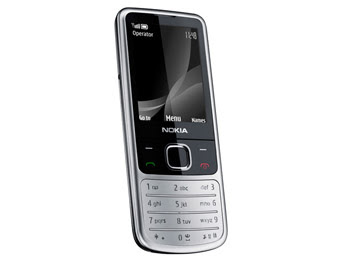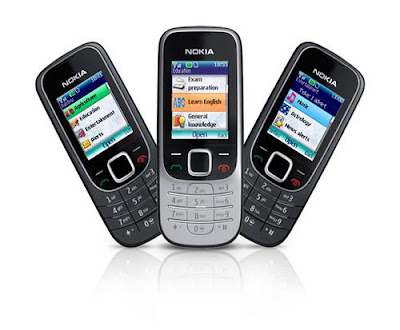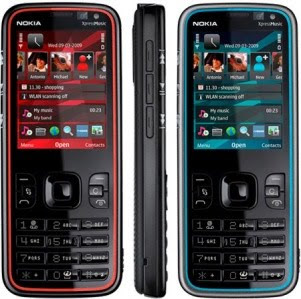Tuesday, March 30, 2010


NOKIA 6303i classic REVIEW
The 6303i classic now comes stomaching enhanced battery talents, enabling you to make up to 8 hours of calls. It’s also capable of letting you listen to around 30 hours of music via its built-in music player and FM radio, and will sit tight for over three weeks on standby.
Extending its rack of communication tools, the 6303i supports instant messaging for enhanced social savviness. It also features a 3.2-megapixel camera with dual LED flash, geared up for easily sharing your sharp snaps online.
We touched on the topic of refinement a few weeks ago and it’s place in mobile innovation and development cycle, and the 6303i classic is certainly another example of this to sit alongside the likes of the similarly honed E72. What do you think?
The 6303i classic begins shipping in selected territories this quarter.
The 6303i uses the S40 6th edition user interface. The interface is simple and intuitive. There is not much change in the UI over its predecessor 6303. The home screen has got slight make over, which features usual status reading like signal & battery status, caller ID. When the keypad is locked, if you press end key, it shows time and date. The menu system also got some renovation. The new mode displays a single icon at a time. The interface is boring as the icons lack the animations. Since it lacks multitasking, you can’t minimize java apps like Opera browser and do other tasks.
The Nokia 6303i Classic offers connectivity in the form of GPRS and EDGE, both of which are class 32. Micro-USB and blue tooth are also included as standard and offer additional connectivity options. The handset comes with an internal memory capacity of 55 MB, with a 2 GB card included in most packages, whilst for further memory capacity the existing microSD card slot and relevant cards can be used to increase capacity up to 16 GB.
The handset offers an impressive 2.2 inch TFT display screen which offers impressive levels of colour variance by virtue of its 16 million colour options. The handset offers the alternative of either ring or vibration alerts as well as the ability to utilise existing MP3 files as ringtones. The phone also comes with a speakerphone which provides effective hands free communication in addition to a 3.5 mm audio jack which offers the option of personal listening, should this be desired or required.
The Classic Nokia 6303i is an impressive handset, styled in a popular style with a range of functionality that makes it a viable option for many.
SPECIFICATIONS
General
2G Network GSM 900 / 1800 / 1900
Announced 2010, February
Status Available. Released 2010, March
Size
Dimensions 108.8 x 46.2 x 11.7 mm, 57 cc
Weight 96 g
Display
Type TFT, 16M colors
Size 240 x 320 pixels, 2.2 inches
Sound
Alert types Vibration, MP3 ringtones
Speakerphone Yes
- 3.5 mm audio jack
Memory
Phonebook 2000 entries, Photocall
Call records 20 dialed, 20 received, 20 missed calls
Internal 55 MB
Card slot microSD, up to 8GB, 2GB included, buy memory
Data
GPRS Class 32
EDGE Class 32
3G No
WLAN No
Bluetooth Yes, v2.1 with A2DP
Infrared port No
USB Yes, microUSB v2.0
Camera
Primary 3.15 MP, 2048x1536 pixels, autofocus, dual LED flash
Video Yes, QVGA@8fps; QCIF@15fps
Secondary No
Features
Messaging SMS, MMS, Email, IM
Browser WAP 2.0/xHTML, HTML
Radio Stereo FM radio with RDS
Games 8 + Downloadable
Colors Steel, Matt Black, Chestnut, Illuvial pink, White on Silver, Khaki on Gold
GPS No
Java Yes, MIDP 2.1
- Nokia Maps 2.0
- H.263/H.264 player
- MP3/WAV/eAAC+/WMA player
- Organizer
- Flash Lite 3.0
- Voice memo/dial
- T9
Labels: NOKIA 6303i classic
Friday, March 26, 2010

 Nokia 2330 Classic REVIEW
Nokia 2330 Classic REVIEWThe Nokia 2330 Classic is an entry level Nokia phone with a classic design. With smooth rounded edges and a stylish flat keypad, the 2330 Classic features a VGA digital camera which can also capture video. Share your photos with friends using the 2330's built in Bluetooth or MMS and Email capabilities. The Nokia 2330 also features a built in FM radio so you can tune in to the latest hits and supports MP3 ringtones so you can choose your favourite track and set it as your ringtone.Presented to us in two colour choices, the Nokia 2330 classic will be available in black with the silver keypad trim, as pictured, or Deep Red. Weighing in at a polite 90 grams and with dimensions of 13.8mm x 46mm x 107mm, this handset fits neatly into most pockets. Offering a 1.8” TFT display with 65k colours and 160 x 128 pixels, the integrated VGA digital camera can be used with ease to create images and videos. These can be stored easily in the 32 Mbytes of memory. For those who like to listen to their favourite FM radio station whenever they can, the dedicated FM Radio key allows easy listening supported by the internal antenna. Once fully charged a talk time of 4.8 hrs and standby time of 540 hrs can be expected. Also offering all the usual suspects of SMS and MMS, Bluetooth® technology and a built in web browser, the user will be able to use the Nokia Xpress audio messaging service to share audio messages with compatible contacts. The Hands Free and Conference call features, audio recording and a good selection of ring tone formats also help to round off this elegant edition to the Nokia Classics range.
In summary, the Nokia 2330 Classic is an elegantly crafted handset which delivers all the minimum aspects we have come to expect in our mobile phones with the quality we have come to expect from Nokia. It is a lovely little phone, ideal for all ages, particularly those who don’t want to be blinded by science but want up to date basic applications. Calling, texting, gaming, web browsing, taking pictures, making videos and listening to music, all from a classy little handset
THE SPECIFICATIONS
General
Status Available
Introduced May 2009
Announced November 2008
Network (2G) GSM 900 / GSM 1800
Form factor Block
Antenna type Internal
SAR Value 0.980 W/Kg
Size
Weight 80.0 g (with battery)
Dimensions 107.0 x 46.0 x 13.0 mm
Display
Type Graphical
Coloured Yes, TFT, 65K colors
Size 1.80 inch
Resolution 128 x 160 pixels
- 5-way navigation key
Memory
Numbers in phone 1000
Received calls 20
Outgoing calls 20
Lost calls 20
Ringtones
Polyphonic ringtones Yes
Ringtone profiles Yes
- MP3
Networking
GPRS Yes
Bluetooth Yes
WAP Yes
Browser Yes, WAP 2.0/xHTML
Email client Yes
Features
Vibration Yes
SMS Send / Receive
MMS Send / Receive
Camera Builtin, VGA, 640x480 pixels
Java Yes, MIDP 2.0
Games Yes
Clock Yes
Alarm Yes
Calculator Yes
Calendar Yes
Voice memo Yes
T9 Yes
Handsfree Yes
FM Radio Yes
Labels: Nokia Classic Series
Thursday, March 25, 2010


Nokia has first ensured that the new 5630 XpressMusic ticks the musical boxes. Comes with Music enabled in selected countries, it’s ready to soak up to 3,000 songs into its slender shell via a 4GB microSD memory card that comes in the box. Likewise, its tuneful talents extend to the ’say and play’ feature (first debuted on the 5320 XpressMusic last year), letting you speak the name of an artist of track to automatically play it. Plus, the Nokia 5630 comes loaded with a 3.5mm headphone connector, stereo Bluetooth, FM stereo and Internet radio to wrap up its music credentials. Now here comes the twist…
Alongside those core talents sit some unusual but welcome suspects on the features front. For starters it’s a full blown S60 device with fast HSDPA connectivity, meaning it’s primed to be loaded with apps and able to exploit many of the best Internet services out there, such as widgets (a la the 5800 and upcoming N97), Ovi Share and Nokia Messaging.
Similarly, it throws N-Gage gaming into the mix – only the second time Nokia’s premium gaming platform has been available on a non Nseries device (the 6210 just got there first). However, at just 12mm slim and weighing only 83g, this makes the Nokia 5630 XpressMusic the slimmest and lightest N-Gage gaming device to date.
Another smart addition is the home screen, which features a new Contacts Bar that has a definite widget feel to it – smartly animated, you can scroll through icons for up to 20 contacts and interact with them directly from the home screen.
The 5630 XpressMusic from Nokia comes with a complete N-Gage experience with an N-Gage shortcut on the homescreen. N-Gage offers an entire catalogue of mobile games from leading game publishers, a multiplayer game feature, and the ability to track progress, as well as add friends to play games against. In addition, the Nokia 5630 cell phone comes with a full focus 3.2 megapixel camera with flash function. Pictures or videos can be captured and shared via a favorite online community, such as Share on Ovi, Flickr, or Facebook.
General
2G Network GSM 850 / 900 / 1800 / 1900
3G Network HSDPA 2100 / 900
Announced 2009, February
Status Available. Released 2009, June
Size
Dimensions 112 x 46 x 12 mm
Weight 83 g
Display
Type TFT, 16M colors
Size 240 x 320 pixels, 2.2 inches
Sound
Alert types Vibration; Downloadable polyphonic, MP3 ringtones
Speakerphone Yes
- 3.5 mm audio jack
- Dedicated music keys
Memory
Phonebook Practically unlimited entries and fields, Photocall
Call records Detailed, max 30 days
Internal 60 MB storage, 128 MB RAM
Card slot microSD, up to 16GB, 4GB included, buy memory
Data
GPRS Class 32
EDGE Class 32
3G HSDPA, 10.2 Mbps; HSUPA, 2 Mbps
WLAN Wi-Fi 802.11 b/g, UPnP technology
Bluetooth Yes, v2.0 with A2DP
Infrared port No
USB Yes, v2.0 microUSB
Camera
Primary 3.15 MP, 2048x1536 pixels, enhanced fixed focus, LED flash
Video Yes
Secondary VGA videocall camera
Features
OS Symbian OS, S60 rel. 3.2
CPU ARM 11 600 MHz processor
Messaging SMS, MMS, Email
Browser WAP 2.0/xHTML
Radio Stereo FM radio with RDS
Games Yes, N-gage + downloadable
Colors Red on black, Blue on grey, Chrome on grey
GPS No
Java Yes, MIDP 2.1
- WMV/RV/MP4/3GP video player
- MP3/WMA/WAV/RA/AAC/M4A music player
- Voice memo
- T9
Labels: Nokia XpressMusic SERIES
Monday, March 22, 2010
Labels: Heat Sinks
Labels: Heat Sinks
Saturday, March 20, 2010
Labels: Heat Sinks
Labels: Heat Sinks
Thursday, March 18, 2010
Labels: Heat Sinks
Labels: Heat Sinks
Tuesday, March 16, 2010


NOKIA C5 SPECIFICATIONS
Brand / Type
Brand Nokia
Type C5
Form factor Candybar
Color Black, White
Network
Phone Network EDGE, GPRS, GSM, HSDPA (3G), HSUPA
Service 850, 900, 1800, 1900, 2100
Connectivity
Bluetooth v2.1 with A2DP
Infrared No
Wi-Fi (WLAN) No
USB MicroUSB v2.0
Fax / Data Yes
Display
Main display Color TFT
Color display 16.000.000 colors
Dimensions 2.2 in.
Resolution 240 x 320 pixels
External display No
Memory
Internal memory 50MB
External memory 16GB
Memory slots Yes
Storage types MicroSD, MicroSDHC
Basic
Battery Standard battery, Li-Ion 860 mAh (BL-5CT)
Standby time 670 hours
Talk time 12 hours
Calling
Vibrate alert Yes
Photo ID Yes
Ringtones MP3
Camera
Camera Yes
Megapixels 3.15 megapixels
Maximum photo resolution 2048x1536 pixels
Digital zoom Yesx
Optical zoom No
Auto focus Yes
Flash Yes
Recording video Yes
Second (front) camera Yes
Messaging
SMS Yes
MMS Yes
T9 text function Yes
E-mail Yes
Internet browsing Yes
Entertainment
FM radio Yes
Java Yes
Audio player eAAC, MP3, WAV
Video player H263, H264, MP4, WMV
Features
Add ringtones Yes
Organiser Document viewer (Word, Excel, PowerPoint, PDF), Organiser, Voice memo
Video call Yes
Other features Symbian OS 9.3, 2GB included, S60 rel. 3.2, Speakerphone, 3.5 mm audio jack, Downloadable games, GPS with A-GPS support, Nokia Maps
Format
Weight 3.2 oz.
Dimensions (H x W x D) 4.4x1.8x0.5 in.
Labels: NOKIA
Labels: Heat Sinks, HEAT TRANSFER
Labels: Heat Sinks, HEAT TRANSFER
Sunday, March 14, 2010
Labels: Heat Sinks, HEAT TRANSFER
Labels: Heat Sinks, HEAT TRANSFER
Friday, March 12, 2010
Thermal Management Using Heat Sinks and Effects of Heat on Electronic Circuits and Devices
0 comments Posted by blogger at 3:53 AMLabels: Heat Sinks
Thermal Management Using Heat Sinks and Effects of Heat on Electronic Circuits and Devices
0 comments Posted by blogger at 3:53 AMLabels: Heat Sinks
Tuesday, March 2, 2010
Based amplifier IC's offer many advantages including high efficiency, high gain, low standby current, low component count, small size and, of course, low cost. It is little wonder that audio amp IC's have replaced most discrete transistors in consumer electronic devices. While many experimenters have stayed away from these little black Mysteries, I am going to uncover some of their secrets and demonstrate how easy they are to use
Rangkaian Amplifier IC LM380
Amplifier IC LM380 comes in two flavors; LM380 and LM380-8 with output powers of 700 milli-watts and 2 watts respectively. A schematic drawing below depicts the 8th and LM380-LM380.
Labels: Home Amplifier, LM Amplifier
Rangkaian Amplifier V-Mosfet 100 Watt
The use of diodes D2 until D5 in combination with the resistances R17-19, they protect the gates of transistors v-fet from exceeds the voltage ± 14V and it creates perforation in very thin layer SiO2, that is used as insulation in the gate. This way of protection is common in all the amplifiers that use these transistors. The total gain of amplifier is 32.6, regulated from the R18, R6 and R8, in the negative feedback. Also is used enough the use of local feedback for stabilisation of operation under all the conditions. Because the transistors v-fet have positive factor of temperature, with result with the increase of temperature is increased also their resistance. This increase has as result the reduction of current that via the transistor, hence also his power. The use of separated supply in the stages of drive and exit, ensures stability and reject of distortion of intermodulation.
Series of VMOS FET POWER [ 2SK134 or 2SK135 ] [ 2SJ49 or 2SJ50 ], they are that, more above transistor they are not produced more by the Toshiba and are enough difficult they are found henceforth. They can be replaced with [ 2SK1530 in the place of 2SK135 ] and [ 2SJ201 in the place of 2SJ50 ]. The new transistors are in plastic case ΤΟ-3Ρ and no TO-3, bear in bigger supply of operation and have positive factor of temperature. This mean that with the increase of temperature, is increased and the current that is gone through from through the transistor. The new transistors him I have still not tryed and me it would interest to learn if somebody him used also with which results.
List Componet
R1=27Kohm
R2-11=4.7Kohm
R3-4=5.6Kohm
R5=47Kohm
R6=1Kohm
R7-10-21=22Kohm
R8=12ohm
R9=1Mohm
R12=33ohm
R13-20=82ohm
R14=33ohm
R15=2.7Kohm
R16=270ohm
R17-19=680ohm
R18=33Kohm
R22-23=0.33ohm 5W
R24=8.2ohm
R25=10ohm 1W
TR1=470ohm trimmer
TR2=4.7Kohm trimmer
C1=1uF 63V mkt
C2=1nF 100V*
C3=100uF 16V
C4=100nF 100V*
C5-7=22uF 16V
C6=4.7pF ceramic
C8=47uF 16V
C9=1nF 100V*
C10-11=100uF 100V
C12-14=100nF 250V mkt
C13=150nF 100V mkt
C15=100uF 35V
D1=12V 0.5W Zener
D2.....5=8.2V 1W Zener
L1=20 turns 0.6mm on R25
Q1-2=BC 547
Q3=2N5460 fet
Q4-5=MPSA93
Q6-8-11=BC182
Q7-10=MPSA43
Q9=BC212
Q12=2SK134 or 2SK135
Q13=2SJ49 or 2SJ50
Labels: Home Amplifier, Mosfet Amplifier





